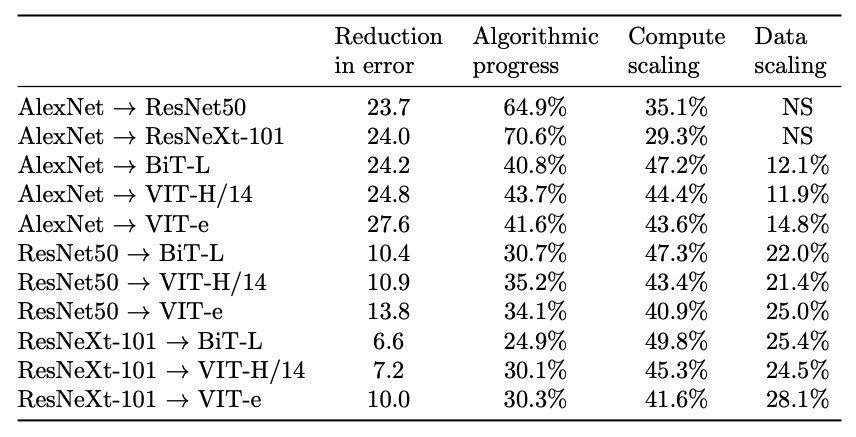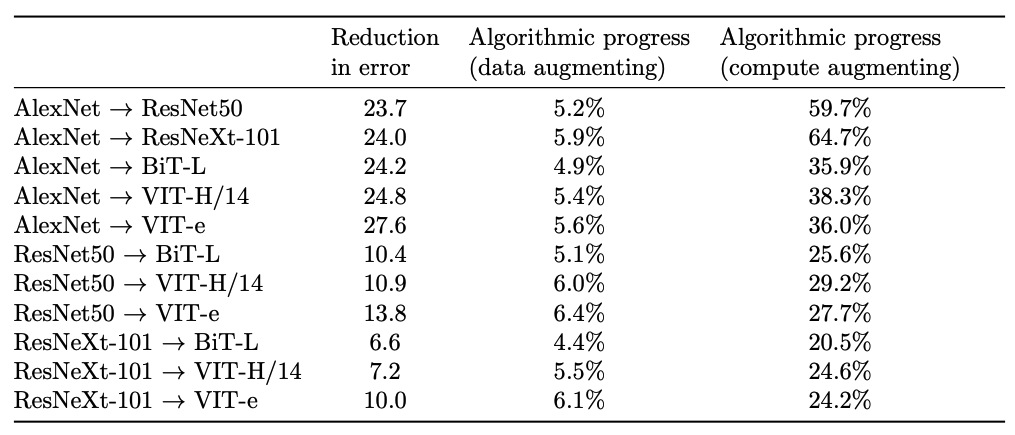How much progress in ML depends on algorithmic progress, scaling compute, or scaling relevant datasets is relatively poorly understood. In our paper, we make progress on this question by investigating algorithmic progress in image classification on ImageNet, perhaps the most well-known test bed for computer vision.
Using a dataset of a hundred computer vision models, we estimate a model—informed by neural scaling laws—that enables us to analyse the rate and nature of algorithmic advances. We use Shapley values to produce decompositions of the various drivers of progress computer vision and estimate the relative importance of algorithms, compute, and data.
Our main results include:
- Every nine months, the introduction of better algorithms contributes the equivalent of a doubling of compute budgets. This is much faster than the gains from Moore’s law; that said, there's uncertainty (our 95% CI spans 4 to 25 months)

- Roughly, progress in image classification has been ~45% due to the scaling of compute, ~45% due to better algorithms, ~10% due to scaling data

- The majority (>75%) of algorithmic progress is compute-augmenting (i.e. enabling researchers to use compute more effectively), a minority of it is data-augmenting

In our work, we revisit a question previously investigated by Hernandez and Brown (2020), which had been discussed on LessWrong by Gwern, and Rohin Shah. Hernandez and Brown (2020) re-implement 15 open-source popular models and find a 44-fold reduction in the compute required to reach the same level of performance as AlexNet, indicating that algorithmic progress outpaces the original Moore’s law rate of improvement in hardware efficiency, doubling effective compute every 16 months.
A problem with their approach is that it is sensitive to the exact benchmark and threshold pair that one chooses. Choosing easier-to-achieve thresholds makes algorithmic improvements look less significant, as the scaling of compute easily brings early models within reach of such a threshold. By contrast, selecting harder-to-achieve thresholds makes it so that algorithmic improvements explain almost all of the performance gain. This is because early models might need arbitrary amounts of compute to achieve the performance of today's state-of-the-art models. We show that the estimates of the pace of algorithmic progress with this approach might vary by around a factor of ten, depending on whether an easy or difficult threshold is chosen. [1]
Our work sheds new light on how algorithmic efficiency occurs, namely that it primarily operates through relaxing compute-bottlenecks rather than through relaxing data-bottlenecks. It further offers insight on how to use observational (rather than experimental) data to advance our understanding of algorithmic progress in ML.
- ^
That said, our estimates is consistent with Hernandez and Brown (2020)'s estimate that algorithmic progress doubles the amount of effective compute every 16 months, as our 95% confidence interval ranges from 4 to 25 months.
This post points to a rather large update, which I think has not yet propagated through the collective mind of the alignment community. Gains from algorithmic improvement have been roughly comparable to gains from compute and data, and much larger on harder tasks (which are what matter for takeoff).
Yet there's still an implicit assumption behind lots of alignment discussion that progress is mainly driven by compute. This is most obvious in discussions of a training pause: such proposals are almost always about stopping very large runs only. That would stop increases in training compute. Yet it's unlikely to slow down algorithmic progress much; algorithmic progress does use lots of compute (i.e. trying stuff out), but it uses lots of compute in many small runs, not big runs. So: even a pause which completely stops all new training runs beyond current size indefinitely would only ~double timelines at best, and probably less (since algorithmic progress is a much larger share than compute and data for harder tasks). Realistically, a pause would buy years at best, not decades.
I've personally cited the linked research within the past year. I think this is a major place where the median person in alignment will look back in a few years and say "Man, we should have collectively updated a lot harder on that".
shrug
I think this is true to an extent, but a more systematic analysis needs to back this up.
For instance, I recall quantization techniques working much better after a certain scale (though I can't seem to find the reference...). It also seems important to validate that techniques to increase performance apply at large scales. Finally, note that the frontier of scale is growing very fast, so even if these discoveries were done with relatively modest compute compared to the frontier, this is still a tremendous amount of compute!